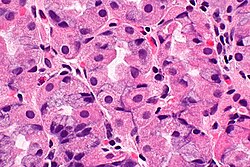Proton pump inhibitor effect
Jump to navigation
Jump to search


Stomach with PPI effect. H&E stain.
Proton pump inhibitor effect, abbreviated PPI effect, is a change seen in the parietal cells of the stomach due to a drug in the proton pump inhibitor class.
Formally, it is stomach with proton pump inhibitor effect.
General
- Due to intake of a proton pump inhibitor (PPI).
- Used to treat gastroesophageal reflux disease.
Some proton pump inhibitors:
- Omeprazole (LOSEC).
- Dexlansoprazole (DEXILANT).
- Lansoprazole (PREVACID).
- Esomeprazole (NEXIUM).
- Pantoprazole (PANTOLOC).
- Rabeprazole (PARIET).
Microscopic
Features:[1]
- Parietal cell enlargement - key feature.
- Parietal cells typically bulge into the lumen.
Images
www:
Sign out
- Usually not reported.


